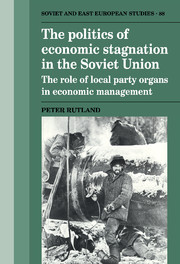 The Politics of Economic Stagnation in the Soviet Union
The Politics of Economic Stagnation in the Soviet Union Book contents
- Frontmatter
- Contents
- List of tables
- Preface
- Glossary of Russian terms and abbreviation
- Introduction: The party in the post-totalitarian system
- 1 The party and the economy: structures and principles
- 2 Party interventions in industry
- 3 Interventions in industry: case studies
- 4 The party as regional coordinator
- 5 Regional coordination: case studies
- 6 The party as fireman: party interventions in the transport and energy sectors
- 7 The role of the party in agriculture
- 8 Non-party control organs
- 9 The principles underlying the party's work with cadres
- 10 The obkom elite in the 1980s
- 11 Party and economy under perestroika
- Conclusion Party and economy in the USSR: from stagnation to collapse
- Appendices
- Notes
- Bibliography
- Index
- THE POLITICS OF ECONOMIC STAGNATION IN THE SOVIET UNION
2 - Party interventions in industry
Published online by Cambridge University Press: 06 July 2010
- Frontmatter
- Contents
- List of tables
- Preface
- Glossary of Russian terms and abbreviation
- Introduction: The party in the post-totalitarian system
- 1 The party and the economy: structures and principles
- 2 Party interventions in industry
- 3 Interventions in industry: case studies
- 4 The party as regional coordinator
- 5 Regional coordination: case studies
- 6 The party as fireman: party interventions in the transport and energy sectors
- 7 The role of the party in agriculture
- 8 Non-party control organs
- 9 The principles underlying the party's work with cadres
- 10 The obkom elite in the 1980s
- 11 Party and economy under perestroika
- Conclusion Party and economy in the USSR: from stagnation to collapse
- Appendices
- Notes
- Bibliography
- Index
- THE POLITICS OF ECONOMIC STAGNATION IN THE SOVIET UNION
Summary
This chapter addresses the general pattern of party interventions in industrial decision making. Chapter 3 examines three specific policy areas where the party organs played a particularly active role – supply procurement, quality control and conservation. Construction and consumer goods production are studied under the rubric of regional coordination (chapter 5), and chapter 6 is devoted to party campaigns in transport and energy.
This chapter focusses on the relationship between party organs and management officials in routine production-related decision-making. Questions of personnel selection, training and promotion are addressed in chapter 9.
The first section establishes that party officials were expected to make sure that plants under their jurisdiction met their plan targets, primarily through exhortation and criticism directed at economic managers. It is unclear, however, just how crucial satisfactory plan performance was to a party official's future career.
The chapter then looks at the role of the party in promoting innovation through integrated science policies, and in the following section examines routine party oversight of technical/production decisions, of efficiency drives, of labour policy, and of enterprise reconstruction.
The next general question addressed is the balance of power between the party and ministerial hierarchies: the autonomy of local directors, and the problems local organs had in dealing with the powerful central ministries. This was the most important factor limiting party influence over the running of Soviet industry. The final section looks at the role played by party organs in attempts to introduce changes and reforms into the Soviet economic mechanism.
- Type
- Chapter
- Information
- The Politics of Economic Stagnation in the Soviet UnionThe Role of Local Party Organs in Economic Management, pp. 49 - 72Publisher: Cambridge University PressPrint publication year: 1992
